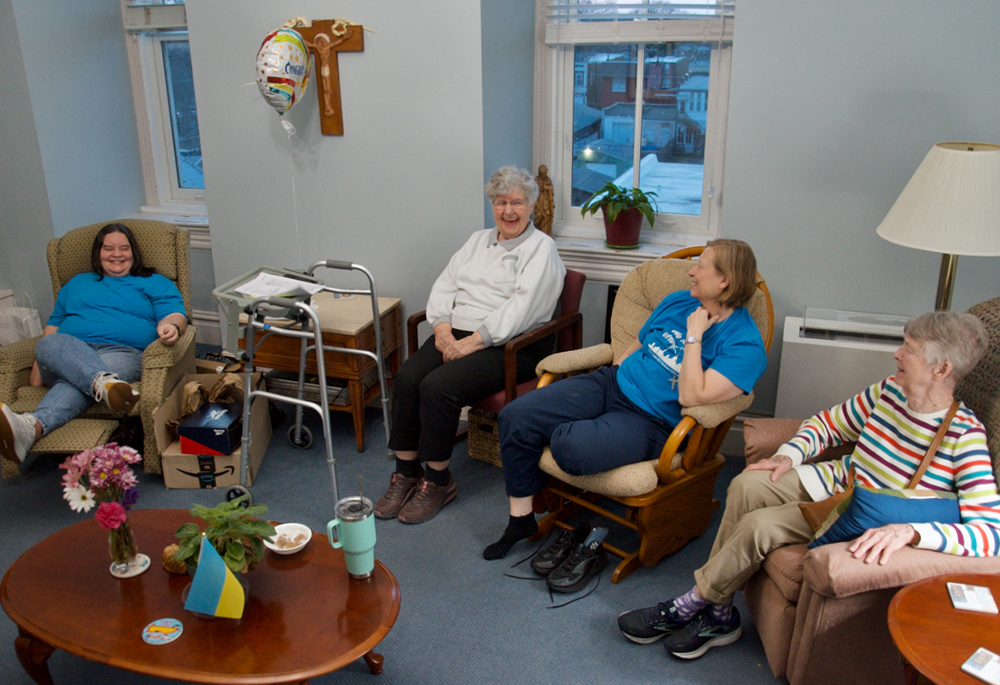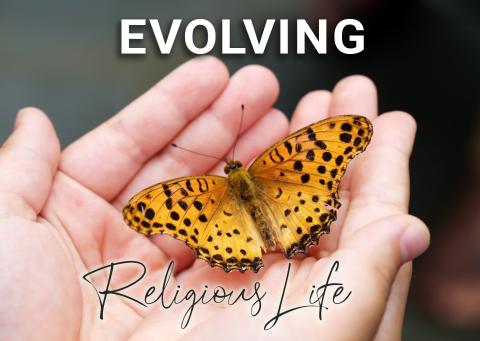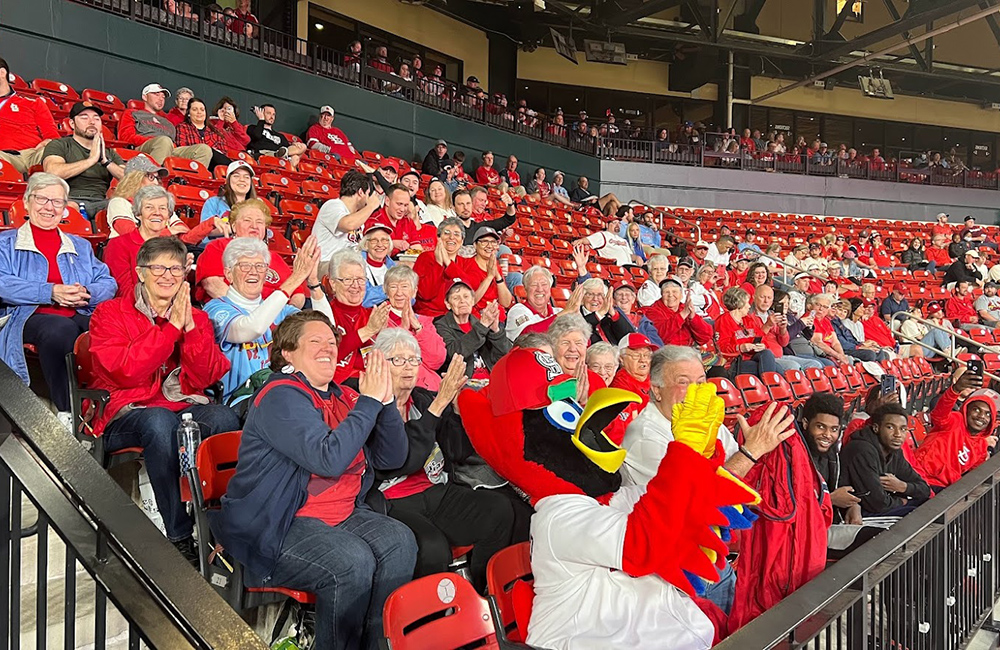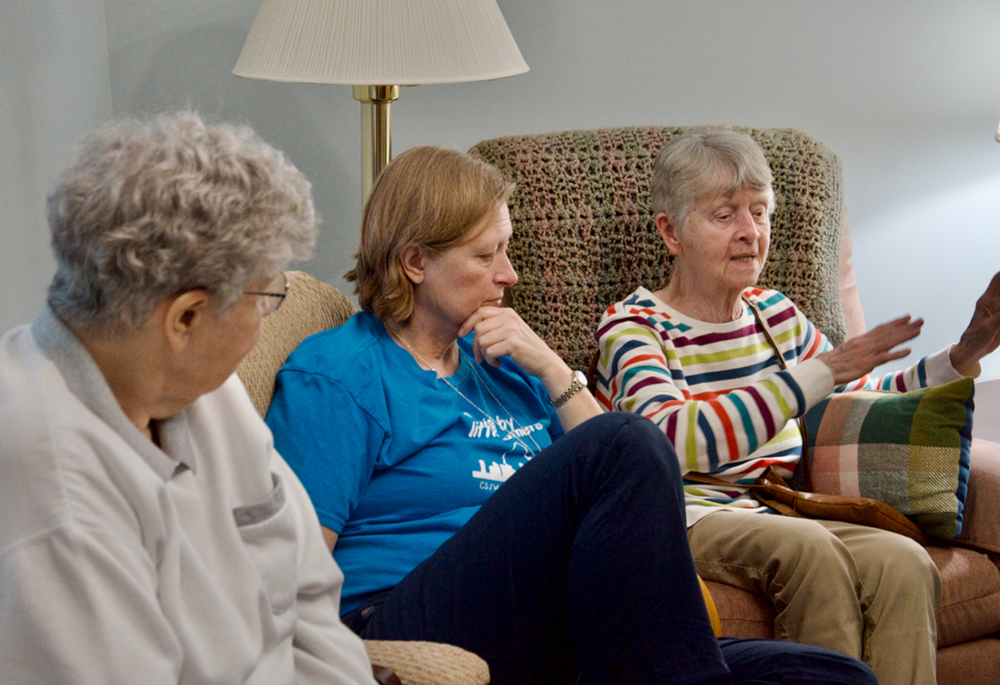
From left, Srs. Sandy Schmid, Emily Meehan, Kristina DeNeve and Pat Quinn relax in their small community's shared space in the motherhouse of the Sisters of St. Joseph of Carondelet in St. Louis. Not shown is Sr. Jo Ann Simanella. Schmid, DeNeve and Quinn are St. Joseph sisters; Meehan and Simanella are members of the Congregation of Divine Providence. (GSR photo/Dan Stockman)
"Evolving Religious Life," a continuing series from Global Sisters Report, explores how Catholic sisters are adapting to the realities of congregations in transition and new forms of religious life. While we write often about these trends, this particular series will focus more closely on sisters' hopes for the future.

It's a normal Tuesday evening in the motherhouse of the Sisters of St. Joseph of Carondelet, and five sisters are relaxing in their common area.
The 27 sisters that live in the St. Louis, Missouri, motherhouse are divided into groups they call "small communities."
But this small community of five is a bit different: Two of the sisters are from the Congregation of Divine Providence. Another small community has no St. Joseph sisters at all — it is made up of five Good Shepherd sisters, and a third community has a Franciscan sister from Uganda while she attends college.
It's not unusual for sisters from different congregations to live in a shared convent, but until recently it rarely happened in an order's motherhouse. Now, as congregations across the United States look to liquidate unused facilities or find a new way to put them to use, it is happening more and more often.
"It's an experiment, but there's a deep desire to make it work," Colleen Kelly, director of communications for the St. Joseph sisters, told Global Sisters Report. "The different congregations are integrated, but maintain their own charisms and traditions."

Sisters enjoy an outing to a St. Louis Cardinals baseball game in 2023. Sisters from four congregations live together in the Sisters of St. Joseph of Carondelet motherhouse. (Courtesy of Monique Tarabeh)
Intercongregational living, once an anomaly, has become a trend among U.S. sisters.
When the Cenacle Sisters in Chicago were forced to sell their retreat center and convent in 2021, they moved 8 miles northwest into the Felician Sisters' convent.
And in Livonia, Michigan, the Felician Sisters are host to Sr. Margretta Wojcik, a Sylvania Franciscan, who lives with them.
Felician Sr. Joyce Marie Van de Vyver said Felicians also follow the Rule of St. Francis, so the fit was a natural one. Wojcik does pastoral work in a nearby parish and needed housing.
"They are a wonderful community," Wojcik said. "We're one group that helps each other, loves each other and enjoys each other."
Advertisement
Van de Vyver said Wojcik is so entwined with the community that she even helps with an older Felician sister who is hearing impaired, taking notes so she doesn't miss announcements.
"She feels that close to the community," said Van de Vyver, the community's local minister. "Because she's also Franciscan, it's easy for her to join in any of our activities or services or our way of life. It's almost a seamless integration."
Sr. Monique Tarabeh, one of the five Good Shepherd sisters living in the St. Joseph motherhouse, said it's more than convenience or good stewardship that the sisters are living together: The Cathedral Basilica of St. Louis, noted for its extensive mosaics, features one that is a scene of when two congregations of Catholic sisters arrived in St. Louis to minister: The Sisters of St. Joseph and the Sisters of the Good Shepherd.

A glass mosaic by Hildreth Meière in the Cathedral Basilica of St. Louis shows the arrival of the Sisters of St. Joseph of Carondelet and the Sisters of the Good Shepherd in St. Louis, Missouri. (Courtesy of the International Hildreth Meière Association)
"Isn't it prophetic to have this?" Tarabeh said.
Even the invitation to move in seemed prophetic. Tarabeh said her congregation's province had a campus that needed renovation, but the expense didn't make financial sense given their needs. When the provincial leader mentioned the need to sell and move elsewhere at a Leadership Council of Women Religious meeting, almost immediately afterward the Sisters of St. Joseph called with their invitation.
"She felt as if it was an invitation from God," Tarabeh said, and in the fall of 2022, the Good Shepherd sisters began moving in, taking an unused wing of the St. Joseph motherhouse.
The diversity is not just among congregations: Tarabeh is Syrian and another Good Shepherd sister is Vietnamese.
"We talk about charism as gifts, and when we are living together, we share our gifts," she said.
They also share traditions: "Super Bowl is very, very, very exciting here," Tarabeh said. "They put it on the big screen, other sisters from St. Louis came, we had a big meal all together of hot dogs and hamburgers. I offered to make crepes, and they were like, 'Crepes for the Super Bowl?' "
Sr. Jo Ann Simanella, one of the Divine Providence sisters living there, said the biggest difference between the congregations is their past.
"We don't have the same history," Simanella said. "It's difficult to have to explain what you're used to taking for granted."

From left, Srs. Emily Meehan and Kristi DeNeve listen to Sr. Pat Quinn talk about sisters from different congregations living together at the motherhouse of the Sisters of St. Joseph of Carondelet in St. Louis. DeNeve and Quinn are St. Joseph sisters; Meehan is from the Congregation of Divine Providence. (GSR photo/Dan Stockman)
As for the different charisms, she said, they don't belong to the sisters anyway, so getting to see other charisms lived out just provides another, deeper perspective.
"Our values are the same, even if they're different charisms," she said. "It's so life-giving. I love it because it stretches me."
Sr. Kristina DeNeve, a St. Joseph sister, said seeing another charism has deepened her love for her own.
"I'm in temporary vows still, and one of the graces is getting to know another charism and getting to know another tradition. It broadens my understanding of religious life and my appreciation of the St. Joseph charism," DeNeve said. "It's not a compare and contrast, but a deepening and broadening."
'I'm in temporary vows still, and one of the graces is getting to know another charism and getting to know another tradition. It broadens my understanding of religious life and my appreciation of the St. Joseph charism. It's not a compare and contrast, but a deepening and broadening.'
—St. Joseph Sr. Kristina DeNeve
There is still some separation amongst the congregations to ensure each keeps its own traditions and maintains community: The five Good Shepherd sisters form their own small community, for example, and all of the St. Joseph sisters have a monthly meeting among themselves.
Having fun together has been an important way to build community despite diverse charisms, ages and backgrounds. Tarabeh organized an outing to a Syrian restaurant; another time the sisters went to a St. Louis Cardinals baseball game.
"We have parties together — any big feast, we try to organize a time to come together, just for fun," Tarabeh said. "Those moments are really important in life, when it's not prayer and meals and work and mission. We also need to be human a little bit and have fun."







